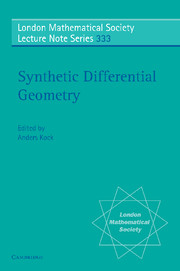I - The synthetic theory
Published online by Cambridge University Press: 29 January 2010
Summary
Introduction
Lawvere has pointed out that “In order to treat mathematically the decisive abstract general relations of physics, it is necessary that the mathematical world picture involve a cartesian closed category ε of smooth morphisms between smooth spaces”.
This is also true for differential geometry, which is a science that underlies physics. So everything in the present Part I takes place in such cartesian closed category ε. The reader may think of ε as “the” category of sets, because most constructions and notions which exist in the category of sets exist in such ε; there are some exceptions, like use of the “law of excluded middle”, cf. Exercise 1.1 below. The text is written as if ε were “the” category of sets. This means that to understand this part, one does not have to know anything about cartesian closed categories; rather, one learns it, at least implicitly, because the synthetic method utilizes the cartesian closed structure all the time, even if it is presented in set theoretic disguise (which, as Part II hopefully will bring out, is really no disguise at all).
Generally, investigating geometric and quantitative relationships brings along with it understanding of the logic appropriate for it. So it also forces ε (which represents our understanding of smoothness) to have certain properties, and not to have certain others. In particular, ε must have finite inverse limits, and, for some of the more refined investigations, it must be a topos.
- Type
- Chapter
- Information
- Synthetic Differential Geometry , pp. 1 - 96Publisher: Cambridge University PressPrint publication year: 2006

